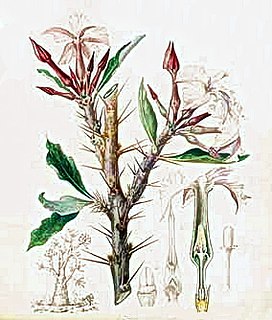
Pachypodium saundersii, the kudu lily, is a succulent plant of the family Apocynaceae. It was named in honour of Sir Charles James Renault Saunders (1857–1931), the Natal Province civil servant and casual plant collector.
The taxonomy of the Pachypodium genus is the study of the species and subspecies in the genus Pachypodium. There are currently 25 recognized species in the genus, of which 17 are shrubs and eight are trees.

Vriesea saundersii is a plant species in the genus Vriesea. This species is endemic to Brazil.

Bolitophila is the sole living genus in the Bolitophilidae, a family of Diptera in the superfamily Sciaroidea, with around 40 Palaearctic and about 20 Nearctic species, and three species from the Oriental region (Taiwan). They are small (6–9 mm.)

Hemaris saundersii, or Saunders' bee hawkmoth, is a moth of the family Sphingidae. The species was first described by Francis Walker in 1856. It is found from southern Kashmir, northern Pakistan, northern India and north-eastern Afghanistan, eastwards along the Himalayan foothills of India to Bangladesh and northern Myanmar. The habitat consists of scrub-jungle at 1,800 to 3,000 metres altitude.
Madremyia is a genus of flies in the family Tachinidae.
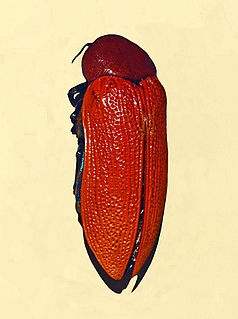
Julodimorpha is a genus of beetles in the family Buprestidae, containing the following species:
Mimicoclytrina is a genus of beetles in the family Buprestidae. It contains the following species:
Crioprosopus saundersii is a species of beetle in the family Cerambycidae. It was described by White in 1853.
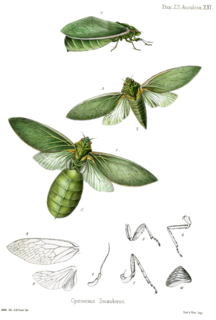
Cystosoma saundersii, commonly known as the bladder cicada, is a species of cicada native to northeastern New South Wales and southeastern Queensland in Australia.
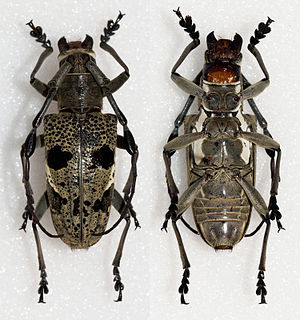
Triammatus is a genus of longhorn beetles of the subfamily Lamiinae, containing the following species:

Xiphotheata is a genus of longhorn beetles of the subfamily Lamiinae, containing the following species:

Dermatobotrys is a rare plant genus endemic to coastal scarp forests in Madagascar and from southern Zululand to the Transkei in South Africa. It consists of a single species, Dermatobotrys saundersii, which is an epiphytic, deciduous shrub, of up to 1 metre (3.3 ft) in height, growing on trees or occasionally on the forest floor. Its flowers are tubular and deep red, followed by smooth, brownish fruit.

Batocera saundersii is a species of beetle in the family Cerambycidae. It was described by Pascoe in 1866. It is known from Sumatra.

Triammatus saundersii is a species of beetle in the family Cerambycidae. It was described by Chevrolat in 1856. It is known from Borneo.

Bolitophila cinerea is a Palearctic species of 'fungus gnat' in the family Bolitophilidae.

Xiphotheata saundersii is a species of beetle in the family Cerambycidae, and the type species of its genus. It was described by Francis Polkinghorne Pascoe in 1864. It is known from Moluccas.
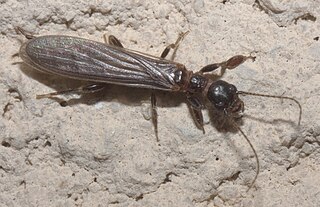
Oligotoma is a genus of webspinners, insects in the order Embiidina, also known as Embioptera. The type species is Oligotoma saundersii and the type locality the Indian subcontinent. The males have wings but the females are flightless. Embiids are recognisable by the enlarged front tarsi, which contain a large number of silk glands that they use to spin the threads they use for building the tubes and galleries in which they live.

Oligotoma saundersii, commonly known as Saunders' embiid, is a species of webspinner, an insect in the order Embiidina, also known as Embioptera.
Madremyia saundersii is a species of bristle fly in the family Tachinidae. It is found in North America.
















